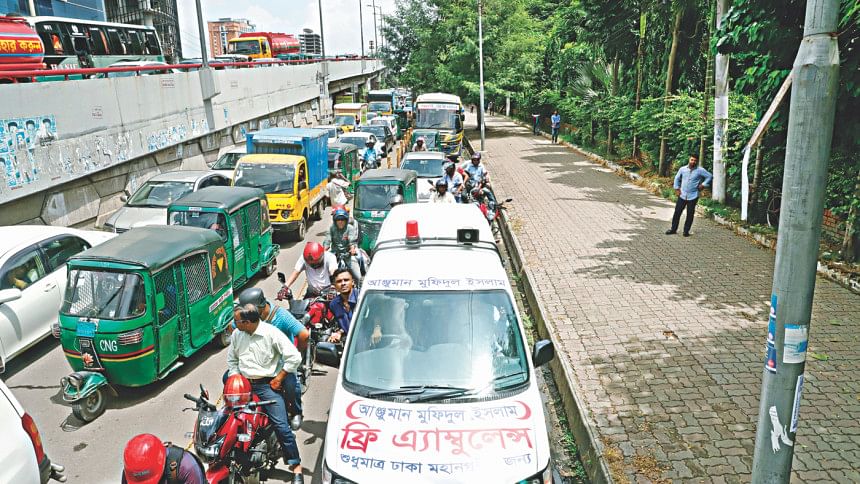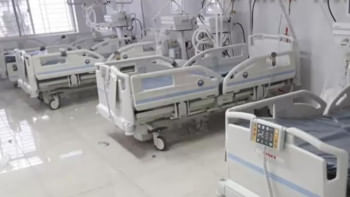Caught Between Life and Traffic

The 17-year-old girl had overdosed herself with multiple drugs. She was first taken to Shaheed Tajuddin Ahmad Medical College in Gazipur. There, she fell unconscious after getting her stomach pumped. The doctors quickly referred her to DMCH, says Rabiul.
"We took one of the private ambulances standing outside the hospital. It got stuck as soon as we reached Jasimuddin Avenue in Uttara. It was moving at a snail's pace until we passed the airport. The whole road was packed with trucks and private cars and no-one bothered to make way for us despite seeing the siren on," describes the distressed father.
"At one point, I got out of the ambulance and yelled at them. But no one paid any heed. Anything could have happened in that two-and-a-half hour journey." According to Google Maps, when traffic is at its lightest, at dawn for example, such a journey would have taken only an hour.
An ambulance driver of DMCH, Md Rana, had a more terrifying tale to share. About two months ago, he was carrying a man aged around 26 year to the National Institute of Cardiovascular Diseases from DMCH. "We got stuck at a traffic signal as soon as we reached the Manik Mia Avenue. We could not move an inch for half an hour. The patient's condition deteriorated, his eyes started to bleed. He probably had a stroke and was declared dead after reaching the hospital."
Zia Hawlader, a CNG-run auto-rickshaw driver, recalls how once he had to follow an ambulance carrying a critical patient—and he managed to reach the hospital before the ambulance. "A police officer from Razarbagh Police Lines was being taken to Square Hospital in Panthapath. His relatives boarded my vehicle and told me to follow the ambulance. But I reached half an hour earlier than the ambulance."
What's in our ambulances?
With traffic taking up valuable time from a patient's life, how equipped are our ambulances to deal with patients in critical conditions?
Currently there are 265 private ambulance services registered under the Dhaka Metropolitan Ambulance Owners Association Ltd. Out of the 1,500 ambulances, only 30 has ICUs (Intensive Care Unit), according to Md Alamgir Hossain, president of the association.
The normal ones have oxygen cylinders and first-aid boxes while the ICU ambulances have a ventilator, cardiac monitor, syringe pump, one paramedic (commonly known as brother), and one doctor.
Alamgir admitted that although drivers and helpers have basic training on handling oxygen, saline, blood transfusion etc, paramedics were essential given Dhaka's traffic situation. "Drivers and helpers, no matter how trained they are, will not understand the condition of a critical patient. They might waste time by going to different hospitals but a paramedic will know which hospital to go to and will also give proper pre-hospital care. This will lower the chances of death," he says.
Then why are paramedics not appointed for all ambulances? To this question, Alamgir replies: "Because that will push up the fare. A paramedic, who has a full-time job in a hospital, charges Tk 1,000 and Tk 4,000 per trip for inside and outside Dhaka respectively. Most patients opt for the normal ambulances."
For a distance like Agargaon to Uttara, the rate of a normal ambulance is Tk 2,000 per trip while the ones with paramedics cost Tk 6,000 per trip. "So including a paramedic in a normal ambulance will increase the rate to Tk 3,000. The rate shoots up to Tk 8,000 per trip when a doctor is also there," says Alamgir.
Transportation delays and the under-use of ambulances appeared as major causes of many deaths and disabilities in Dhaka, in a 2017 study available on the website of BMJ, one of the world's oldest general medical journals. After observing four Dhaka hospitals for a week and analysing medical records, it was found that, of 734 emergency patients, 63 percent arrived by rickshaws or motor-rickshaws, 25.7 percent by bus or car, and only 11.3 percent by ambulances.
Families of 56 emergency patients and 23 stakeholders were also interviewed. The results showed that 80.4 percent of the patients' relatives did not wait for ambulance due to unavailability or not knowing the phone number. The median delay of ambulances was 85 minutes—when calculating the time delay just during day-time, the median was found to be 102 minutes.
The findings mirror Alamgir's words. "On an average, we get only five calls for ICU ambulances in a month. Most people do not call 999. They take private cars or CNG-rickshaws, or microbuses with no pre-hospital care arrangements.
"One solution could be hiring paramedics at monthly salaries but most people do not understand the importance of paramedics and ambulances until they incur some grave loss. So, we cannot hire paramedics for all the ambulances until the demand is felt." There are no rules that regulate what an ambulance must have. The Bangladesh Road Transport Authority checks the ambulance for some basic features, and accordingly issues the road permits.
In 2016, Minister for Health and Family Welfare Zahid Maleque, who was then the state minister of the same department, instructed the Directorate General of Health Services (DGHS) and the ministry to jointly formulate a policy to set standards.
When asked on the current status of the policy, Zakia Sultana, additional secretary at the health ministry, said, "Yes, a draft of such a policy was underway in 2016. It was mainly related to the purchase rates and distribution of ambulance. The draft was sent to the finance ministry for review but they never sent it back to us."
No progress on the policy was made since 2016, according to Alamgir. However, the Directorate General of Health Services and the police sought names of the ambulance service owners and vehicle details from him.
"I received two letters—the police sent one last year and the DGHS three months ago. They wanted the lists for updating databases for their respective hotlines [999 and 16263]. No directive was issued on improving the service."
In Alamgir's opinion, quality ambulance service could be provided at minimal cost if the government exempted the owners from paying duties on purchase and reduced renewal fees. He said the ambulance service sector was not subsidised by the government.
WHERE IS OUR EMERGENCY LANE?
Last year, when students took to the streets after a bus ploughed through two of their fellows, pictures and video footages of vehicles neatly moving in rows on Dhaka streets surfaced in the media (electronic, print, and social). On the right side of all roads, a lane was kept empty by the students—it was an emergency lane for ambulances. As the movement fizzled out, and the police took over the streets again, the emergency lane too disappeared. Why is it, that the students managed to pull off this feat, but our law enforcers cannot?
Mahbub E Rabbani, director (road safety) at BRTA, claims it is because public buses and private cars hardly came out then. "It was quite easy to create a lane for ambulance with such little number of vehicles present on the roads. That was an exceptional period. Things are usually not like that. If it was, we would have created separate lanes for ambulance, bicycle etc long ago," he claims.
Given the current situation, the query arises: could that much criticised lane actually bring any form of respite?
"Not really. Now our entire road and traffic system is beset with so many problems that one single drug cannot cure them all," said Kazi Md Shifun Newaz, assistant professor, Accident Research Institute, BUET. "In a city like Dhaka, it is not feasible to have emergency lanes on every road. It can be created on roads having at least three lanes but most of our roads have just one or two lanes."
"Some roads can have specific lanes that both public transports and emergency vehicles can share. But surveys need to be done; data needS to be collected and analysed in order to find out which roads are suitable for that," observed Newaz.
"From time to time, the government comes up with drastic decisions; banning rickshaws for example. But extensive research is needed in this field," he added.
All parties believe that general commuters do not have adequate compassion for ambulances.
"Dhaka's traffic situation is so messed up that people are not willing to make way for us. In fact, they get annoyed if we keep the siren on while stuck in middle of the road," describes ambulance driver Rana.
Traffic sergeants deployed on Dhaka roads claim that they clear the signals whenever they see any ambulance stuck. "When it is stuck far behind or is out of my sight, then someone from that vehicle has to come and tell me," said Md Azizul, constable of Dhaka Metropolitan Police traffic unit (Dhanmondi zone).
Rabiul Alam however had a different real-life experience. "A traffic sergeant could very well see that our ambulance was stuck and the siren was on. I did not see him making any move."
Take the death of 11-year-old Titash Ghosh as an example. The school boy died on July 25, in an ambulance midriver, after a ferry was delayed in Madaripur for three hours for a joint secretary. The boy's death initiated a plethora of discussions on whether a ferry carrying a critical patient can be delayed like this.
In its initial order, the High Court observed that "Ambulances are allowed to pass on the basis of priority even if there is a VIP because the issue of life and death is relevant here."
A high-profile government probe committee, however, has found no "logical grounds" to hold Joint Secretary Abdus Sabur Mondal responsible for the ferry delay, and accused the ferry officials instead. Does this reflect our inability to get to the root of the problem?
Promiti Prova Chowdhury is a subeditor at The Daily Star.

 For all latest news, follow The Daily Star's Google News channel.
For all latest news, follow The Daily Star's Google News channel. 



Comments